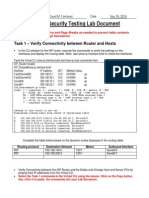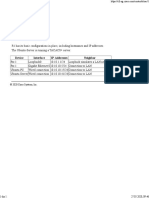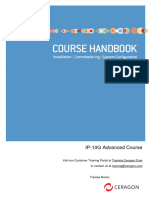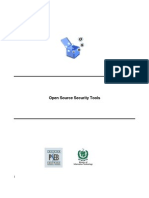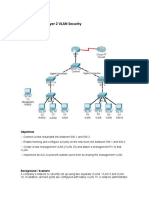Discovery 25: Configure Standard and Extended Acls
Discovery 25: Configure Standard and Extended Acls
Uploaded by
Ionut StanciuCopyright:
Available Formats
Discovery 25: Configure Standard and Extended Acls
Discovery 25: Configure Standard and Extended Acls
Uploaded by
Ionut StanciuOriginal Title
Copyright
Available Formats
Share this document
Did you find this document useful?
Is this content inappropriate?
Copyright:
Available Formats
Discovery 25: Configure Standard and Extended Acls
Discovery 25: Configure Standard and Extended Acls
Uploaded by
Ionut StanciuCopyright:
Available Formats
Procedure https://cll-ng.cisco.
com/content/xtrac/2
Discovery 25: Configure Standard and Extended ACLs
Task 1: Configure and Verify ACLs
Activity
It is always advisable to test network connectivity and services before applying ACL filtering. This ensures that the network is fully functional, and that the
loss of connectivity or functionality is due to the applied ACLs and not a pre-existing network issue.
Step 1: Using Telnet, perform the following tests:
PC1 can successfully Telnet to R1 using port 23
PC1 can successfully Telnet to SRV1 using port 80 and 443
PC1 can successfully Telnet to SRV2 using port 80 and 443
PC2 can successfully Telnet to SRV1 using port 80 and 443
Note
When telnetting to port 80 or 443 you might need to press Enter to get the system to respond after the session is established.
On PC1 and PC2, enter the following commands:
PC1# telnet r1
Translating "r1"...domain server (203.0.113.30) [OK]
Trying r1 (198.51.100.2)... Open
User Access Verification
Password: (cisco)
Password:
R1> exit
[Connection to r1 closed by foreign host]
PC1# telnet srv1 80
Translating "srv1"...domain server (203.0.113.30) [OK]
Trying srv1 (10.10.2.20, 80)... Open
HTTP/1.1 400 Bad Request
Date: Thu, 18 Jul 2019 11:53:53 GMT
Server: cisco-IOS
Accept-Ranges: none
400 Bad Request
[Connection to srv1 closed by foreign host]
PC1# telnet srv1 443
Translating "srv1"...domain server (203.0.113.30) [OK]
Trying srv1 (10.10.2.20, 443)... Open
[Connection to srv1 closed by foreign host]
PC1# telnet srv2 80
Translating "srv2"...domain server (203.0.113.30) [OK]
Trying srv2 (203.0.113.30, 80)... Open
HTTP/1.1 400 Bad Request
Date: Thu, 18 Jul 2019 11:55:28 GMT
Server: cisco-IOS
Accept-Ranges: none
400 Bad Request
[Connection to srv2 closed by foreign host]
PC1# telnet srv2 443
Translating "srv2"...domain server (203.0.113.30) [OK]
Trying srv2 (203.0.113.30, 443)... Open
[Connection to srv2 closed by foreign host]
PC2# telnet srv1 80
Translating "srv1"...domain server (203.0.113.30) [OK]
Trying srv1 (10.10.2.20, 80)... Open
1 din 5 27.05.2020, 09:31
Procedure https://cll-ng.cisco.com/content/xtrac/2
HTTP/1.1 400 Bad Request
Date: Thu, 18 Jul 2019 11:57:19 GMT
Server: cisco-IOS
Accept-Ranges: none
400 Bad Request
[Connection to srv1 closed by foreign host]
PC2# telnet srv1 443
Trying srv1 (10.10.2.20, 443)... Open
[Connection to srv1 closed by foreign host]
PC2#
Notice the use of device domain names (srv1, srv2, r1) during testing. Recall that SRV2 is a DNS server replying to queries it receives.
Step 2: All tests are successful. Telnet is used to verify port 80 and port 443 functionality on SRV1 and SRV2. After the Telnet session opens, you can use
any character key followed by the Enter key to close the connection.
Step 3: Standard ACLs can filter traffic based on source IP address only. A typical best practice is to configure a standard ACL as close to the destination
as possible. In this step, you are configuring a numbered standard ACL on R1. The ACL is designed to block traffic from host 10.10.1.10 to the
10.10.2.0/24 network on R1. This ACL will be applied outbound on the R1 Ethernet 0/1 interface.
On R1, enter the following commands:
R1(config)# access-list 1 deny host 10.10.1.10
R1(config)# access-list 1 permit any
R1(config)# interface Ethernet 0/1
R1(config-if)# ip access-group 1 out
The purpose of this ACL is to block host PC1 from accessing the 10.10.2.0/24 network but allow all other traffic. Remember that every ACL has an
implicit “deny any” that causes all traffic that has not matched a statement in the ACL to be blocked. For this reason, the permit any statement was added
to the end of the ACL.
The ACL is applied in the out direction on interface Ethernet 0/1 since that is the closest interface to the destination you are trying block.
Step 4: Test the ACL by pinging from PC1 to SRV1. Since the ACL is designed to block traffic with source addresses from the 10.10.1.10 host, PC1
should not be able to ping SRV1. Perform a similar test from PC2 to ensure that other devices still have access to SRV1. Verify the ACL using the show
access-list command.
On PC1, enter the following command:
PC1# ping srv1
Translating "srv1"...domain server (203.0.113.30) [OK]
Type escape sequence to abort.
Sending 5, 100-byte ICMP Echos to 10.10.2.20, timeout is 2 seconds:
U.U.U
Success rate is 0 percent (0/5)
First notice that the DNS requests that to SRV2 are still functional. SRV2 has resolved the “srv1” domain name and returned the 10.10.2.20 address to PC1.
PC1 then sends five echo-request messages to SRV1 but R1 drops the packets and returns ICMP destination unreachable messages to PC1 because of the
deny statement in the ACL.
On PC2, enter the following command:
PC2# ping srv1
Translating "srv1"...domain server (203.0.113.30) [OK]
Type escape sequence to abort.
Sending 5, 100-byte ICMP Echos to 10.10.2.20, timeout is 2 seconds:
!!!!!
Success rate is 100 percent (5/5), round-trip min/avg/max = 1/1/1 ms
Connectivity to SRV1 from other sources still works because of the permit any statement in the ACL.
On R1, enter the following command:
R1# show access-list
Standard IP access list 1
10 deny 10.10.1.10 (8 matches)
20 permit any (5 matches)
You should see matches for both access control entries (ACEs) as packets from PC1 were denied and packets from PC2 were permitted through the ACL.
Step 5: As a network administrator, it is important to have remote access to your routers, switches, and firewalls. This access should not be available to
other users of the network. Therefore, you will configure and apply a named standard ACL that allows PC1 access to the vty lines on R1, but explicitly
denies all other source IP addresses. Use the log keyword to generate a syslog message at the console when a connection attempt is blocked.
On R1, enter the following commands:
R1(config)# ip access-list standard VTY-ACCESS
R1(config-std-nacl)# permit host 10.10.1.10
R1(config-std-nacl)# deny any log
R1(config-std-nacl)# exit
R1(config)# line vty 0 4
R1(config-line)# access-class VTY-ACCESS in
A named standard ACL called VTY-ACCESS is configured with one permit statement for PC1’s IP address and an explicit deny any statement allowing
you to apply the log keyword. During testing, the first packet in a flow will trigger a syslog message. Logging-enabled ACLs provide insight into traffic as
2 din 5 27.05.2020, 09:31
Procedure https://cll-ng.cisco.com/content/xtrac/2
it traverses the network or is dropped by network devices. Unfortunately, ACL logging can be CPU intensive and can negatively affect other functions of
the network device. There are two primary factors that contribute to the CPU load increase from ACL logging: process switching of packets that match log-
enabled access control entries (ACEs) and the generation and transmission of log messages. Care should be taken when using the log option in a production
network.
The ACL is then applied to all router vty lines in the in direction since the connection attempts will be viewed as inbound from the perspective of the
router.
Step 6: Test the ACL by initiating a Telnet session from PC1 to R1. Repeat the test from PC2 To R1. On R1, verify the syslog messages and the ACL
matches.
On PC1, P2, and R1, enter the following commands:
PC1# telnet r1
Translating "r1"...domain server (203.0.113.30) [OK]
Trying r1 (198.51.100.2)... Open
User Access Verification
Password: (cisco)
R1> exit
[Connection to r1 closed by foreign host]
PC1#
PC2# telnet r1
Translating "r1"...domain server (203.0.113.30) [OK]
Trying r1 (198.51.100.2)...
% Connection refused by remote host
R1#
*Jul 19 04:13:17.927: %SEC-6-IPACCESSLOGNP: list VTY-ACCESS denied 0 203.0.113.40 -> 0.0.0.0, 1 packet
R1# show access-list VTY-ACCESS
Standard IP access list VTY-ACCESS
10 permit 10.10.1.10 (2 matches)
20 deny any log (1 match)
The Telnet connection from PC1 to R1 is successful but not from PC2. Because of the log keyword, a syslog message is triggered by the explicit deny any
statement at the end of the ACL. The message confirms the source of the failed connection attempt (PC2). The show access-list VTY-ACCESS command
indicates matches for both ACEs since packets were permitted from PC1 and denied from PC2.
When greater granularity is required, you can use an extended ACL. Extended ACLs can filter traffic based on more than just source address. Extended ACLs
can filter on protocol, source, and destination IP addresses, and source and destination port numbers.
Step 7: In this step, you will configure a complex named extended ACL on R1 that will act as a traffic filter for request or replies that originate in the
public IP address space on the right of the topology, and that are destined for the private IP address space on the left of the topology.
The access list will be applied on R1 to interface Ethernet 0/3 in the inbound direction with the following objectives in mind:
Allowing any public devices HTTP and HTTPS access to SRV1
Allowing Ping replies to the 10.10.1.0/24 network from any public devices
Allowing DNS replies to the 10.10.1.0/24 network from SRV2
Allowing HTTP and HTTPS replies to the 10.10.1.0/24 network from any public devices.
Explicitly denying all other traffic.
On R1, enter the following commands:
R1(config)# ip access-list extended TRAFFIC-FILTER
R1(config-ext-nacl)# permit tcp any host 10.10.2.20 eq www
R1(config-ext-nacl)# permit tcp any host 10.10.2.20 eq 443
R1(config-ext-nacl)# permit icmp any 10.10.1.0 0.0.0.255 echo-reply
R1(config-ext-nacl)# permit udp host 203.0.113.30 eq domain 10.10.1.0 0.0.0.255
R1(config-ext-nacl)# permit tcp any eq www 10.10.1.0 0.0.0.255 established
R1(config-ext-nacl)# permit tcp any eq 443 10.10.1.0 0.0.0.255 established
R1(config-ext-nacl)# deny ip any any
R1(config-ext-nacl)# exit
R1(config)# interface Ethernet 0/3
R1(config-if)# ip access-group TRAFFIC-FILTER in
A named extended ACL called TRAFFIC-FILTER is configured with the following ACEs:
Permit any public device HTTP access to SRV1.
Permit any public device HTTPS access to SRV1.
Permit ICMP Ping replies to the PC1 network from any public source.
Permit DNS replies to the PC1 network from the DNS server SRV2.
Permit HTTP replies to the PC1 network from any public source.
Permit HTTPS replies to the PC1 network from any public source.
Deny all other traffic.
3 din 5 27.05.2020, 09:31
Procedure https://cll-ng.cisco.com/content/xtrac/2
Notice the use of the established parameter for two of the ACEs. The established parameter allows only responses to traffic that originated from the
10.10.1.0/24 network to return to that network from any HTTP or HTTPS public server. A match occurs if the returning TCP segment has the ACK or reset
(RST) bits set, which indicates that the packet belongs to a pre-established connection. Without the established parameter in the ACL statement, clients could
send traffic to a web server, but not receive traffic returning from that web server.
When filtering return traffic, the source port number must be checked. You can see this being accomplished in lines 4, 5, and 6.
The ACL is applied inbound on R1’s public-facing interface (Ethernet 0/3) since the objective is to filer traffic arriving from the public IP address space.
Step 8: Perform the following tests to verify ACL functionality:
PC2 can successfully Telnet to SRV1 using port 80
PC2 can successfully Telnet to SRV1 using port 443
PC1 can successfully Ping SRV2 using name resolution (this tests ACE #3 and #4)
PC1 can successfully Telnet to SRV2 using port 80
PC2 can successfully Telnet to SRV2 using port 443
All other tests should fail.
On PC1 and PC2, enter the following commands:
PC2# telnet srv1 80
Translating "srv1"...domain server (203.0.113.30) [OK]
Trying srv1 (10.10.2.20, 80)... Open
HTTP/1.1 400 Bad Request
Date: Fri, 19 Jul 2019 06:47:02 GMT
Server: cisco-IOS
Accept-Ranges: none
400 Bad Request
[Connection to srv1 closed by foreign host]
PC2# telnet srv1 443
Translating "srv1"...domain server (203.0.113.30) [OK]
Trying srv1 (10.10.2.20, 443)... Open
[Connection to srv1 closed by foreign host]
PC2#
PC1# ping srv2
Translating "srv2"...domain server (203.0.113.30) [OK]
Type escape sequence to abort.
Sending 5, 100-byte ICMP Echos to 203.0.113.30, timeout is 2 seconds:
!!!!!
Success rate is 100 percent (5/5), round-trip min/avg/max = 1/1/1 ms
PC1# telnet srv2 80
Translating "srv2"...domain server (203.0.113.30) [OK]
Trying srv2 (203.0.113.30, 80)... Open
HTTP/1.1 400 Bad Request
Date: Fri, 19 Jul 2019 06:49:10 GMT
Server: cisco-IOS
Accept-Ranges: none
400 Bad Request
[Connection to srv2 closed by foreign host]
PC1# telnet srv2 443
Translating "srv2"...domain server (203.0.113.30) [OK]
Trying srv2 (203.0.113.30, 443)... Open
[Connection to srv2 closed by foreign host]
PC2# ping pc1
Translating "pc1"...domain server (203.0.113.30) [OK]
Type escape sequence to abort.
Sending 5, 100-byte ICMP Echos to 10.10.1.10, timeout is 2 seconds:
U.U.U
Success rate is 0 percent (0/5)
All tests are successful, except the Ping from PC2 to PC1. This type of traffic is not permitted through the ACL. R1 returns ICMP destination unreachable
messages to PC2 when these packets are dropped.
Step 9: On R1, verify the TRAFFIC-FILTER ACL.
On R1, enter the following command:
R1# show access-lists TRAFFIC-FILTER
Extended IP access list TRAFFIC-FILTER
4 din 5 27.05.2020, 09:31
Procedure https://cll-ng.cisco.com/content/xtrac/2
10 permit tcp any host 10.10.2.20 eq www (13 matches)
20 permit tcp any host 10.10.2.20 eq 443 (12 matches)
30 permit icmp any 10.10.1.0 0.0.0.255 echo-reply (5 matches)
40 permit udp host 203.0.113.30 eq domain 10.10.1.0 0.0.0.255 (3 matches)
50 permit tcp any eq www 10.10.1.0 0.0.0.255 established (6 matches)
60 permit tcp any eq 443 10.10.1.0 0.0.0.255 established (7 matches)
70 deny ip any any (5 matches)
Each ACE indicates several matches. This shows that packets were either permitted or denied depending on the action configured in each statement.
Step 10: Modify the TRAFFIC-FILTER ACL on R1 to allow PC2 SSH access to SRV1. Insert this new ACE at line 65 of the ACL.
On R1, enter the following commands:
R1(config)# ip access-list extended TRAFFIC-FILTER
R1(config-ext-nacl)# 65 permit tcp host 203.0.113.40 host 10.10.2.20 eq 22
Sequence numbers can be used to delete or insert an ACL statement. The ip access-list extended name command is used to enter named-ACL
configuration mode. If the ACL is numbered instead of named, the ACL number is used for the name parameter. ACEs can be inserted or removed using
the no keyword. For example, in named-ACL configuration mode, the command no 40 would delete line 40 of the ACL.
Line 65 is configured to only allow PC2 to connect to SRV1 using SSH.
Step 11: On PC2, open an SSH connection with SRV1 to test the new ACE entry. Use the username (admin) with password (cisco).
On PC2, enter the following commands:
PC2# ssh -l admin 10.10.2.20
Password: (cisco)
SRV1>
SRV1> exit
[Connection to 10.10.2.20 closed by foreign host]
PC2#
The SSH connection is successful.
Step 12: On R1, verify the TRAFFIC-FILTER ACL for line 65 matches.
On R1, enter the following command:
R1# sh access-lists TRAFFIC-FILTER
Extended IP access list TRAFFIC-FILTER
10 permit tcp any host 10.10.2.20 eq www (13 matches)
20 permit tcp any host 10.10.2.20 eq 443 (12 matches)
30 permit icmp any 10.10.1.0 0.0.0.255 echo-reply (5 matches)
40 permit udp host 203.0.113.30 eq domain 10.10.1.0 0.0.0.255 (3 matches)
50 permit tcp any eq www 10.10.1.0 0.0.0.255 established (6 matches)
60 permit tcp any eq 443 10.10.1.0 0.0.0.255 established (7 matches)
65 permit tcp host 203.0.113.40 host 10.10.2.20 eq 22 (32 matches)
70 deny ip any any (5 matches)
The new ACL at line 65 shows that several packets have matched and were permitted through the ACL.
© 2020 Cisco Systems, Inc.
5 din 5 27.05.2020, 09:31
You might also like
- TheTechBlackBoard-AZ-104 - 190questions - SampleDocument9 pagesTheTechBlackBoard-AZ-104 - 190questions - SampledivyanshugroverNo ratings yet
- Network Security All-in-one: ASA Firepower WSA Umbrella VPN ISE Layer 2 SecurityFrom EverandNetwork Security All-in-one: ASA Firepower WSA Umbrella VPN ISE Layer 2 SecurityNo ratings yet
- GX-CS - Cheat Sheet - Hping3Document2 pagesGX-CS - Cheat Sheet - Hping3bogeybogey6891No ratings yet
- D 3 Challenge Acl LabDocument5 pagesD 3 Challenge Acl LabAmadouMalickMouamfonMoumbagnaNo ratings yet
- Cisco CCNA Command Guide: An Introductory Guide for CCNA & Computer Networking Beginners: Computer Networking, #3From EverandCisco CCNA Command Guide: An Introductory Guide for CCNA & Computer Networking Beginners: Computer Networking, #3No ratings yet
- 4.4.1.2 Packet Tracer - Configure IP ACLs To Mitigate Attacks - InstructorDocument20 pages4.4.1.2 Packet Tracer - Configure IP ACLs To Mitigate Attacks - InstructorMario SuarezNo ratings yet
- H12-211 - Huawei Real Exam Questions - 100% Free - Exam-LabsDocument217 pagesH12-211 - Huawei Real Exam Questions - 100% Free - Exam-LabsRoman TravinNo ratings yet
- 26.2.2 Packet Tracer - Configure Extended IPv4 ACLs - Scenario 2 - ILMDocument4 pages26.2.2 Packet Tracer - Configure Extended IPv4 ACLs - Scenario 2 - ILMTRYST CHAMANo ratings yet
- 5.4.13 Packet Tracer - Configure Extended IPv4 ACLs - Scenario 2Document4 pages5.4.13 Packet Tracer - Configure Extended IPv4 ACLs - Scenario 2WerrtyNo ratings yet
- QuintoARonyZambrano5 4 13Document4 pagesQuintoARonyZambrano5 4 13roniakolaNo ratings yet
- ACL Practice Lab 3Document8 pagesACL Practice Lab 3LGBT Việt NamNo ratings yet
- Basic Access Control ListsDocument10 pagesBasic Access Control ListsVeera KrishnaNo ratings yet
- ACL Practice Lab 1Document8 pagesACL Practice Lab 1LGBT Việt NamNo ratings yet
- ACL Practice Lab 2Document7 pagesACL Practice Lab 2LGBT Việt NamNo ratings yet
- Lab 11 Network Security Basics and Network AccessDocument19 pagesLab 11 Network Security Basics and Network AccessAIZUDDIN ASMANNo ratings yet
- 4.2.2.12 Packet Tracer - Configuring Extended ACLs Scenario 3 - ILMDocument11 pages4.2.2.12 Packet Tracer - Configuring Extended ACLs Scenario 3 - ILMdiego rubioNo ratings yet
- (Instructor Version) : Packet Tracer - Configuring Extended Acls - Scenario 3 Desarrollado Por: Oscar Vanegas LandinezDocument6 pages(Instructor Version) : Packet Tracer - Configuring Extended Acls - Scenario 3 Desarrollado Por: Oscar Vanegas LandinezOscar PerdomoNo ratings yet
- 4.2.2.10 Packet Tracer - Configuring Extended ACLs Scenario 1Document4 pages4.2.2.10 Packet Tracer - Configuring Extended ACLs Scenario 1Elizabeth BarreraNo ratings yet
- 4.4.1.2 Packet Tracer - Configure IP ACLs To Mitigate Attacks - InstructorDocument17 pages4.4.1.2 Packet Tracer - Configure IP ACLs To Mitigate Attacks - InstructorJuan Miguel MuñozNo ratings yet
- Lab 8 Packet Tracer VersionDocument6 pagesLab 8 Packet Tracer VersionOsGuIsNo ratings yet
- 9.3.2.10 Configuring Extended ACLs Scenario 1 InstructionsDocument4 pages9.3.2.10 Configuring Extended ACLs Scenario 1 InstructionsJorge JuarezNo ratings yet
- Exercices ACLDocument9 pagesExercices ACLPapa NiangNo ratings yet
- Acl 4.2.2.10 Packet Tracer - Configuring Extended ACLs Scenario 1Document3 pagesAcl 4.2.2.10 Packet Tracer - Configuring Extended ACLs Scenario 1Emerson Emerson AemersonNo ratings yet
- Lab 1.4.3 Introductory Lab 3 - Access Control List Basics and Extended PingDocument5 pagesLab 1.4.3 Introductory Lab 3 - Access Control List Basics and Extended PingnickNo ratings yet
- 4.2.2.10 Packet Tracer - Configuring Extended ACLs Scenario 1Document9 pages4.2.2.10 Packet Tracer - Configuring Extended ACLs Scenario 1fabian rodriguezNo ratings yet
- 9.3.2.12 Configuring Extended ACLs Scenario 3 Instructions PDFDocument3 pages9.3.2.12 Configuring Extended ACLs Scenario 3 Instructions PDFEder MonteiroNo ratings yet
- 5.4.12 Packet Tracer - Configure Extended IPv4 ACLs - Scenario 1Document5 pages5.4.12 Packet Tracer - Configure Extended IPv4 ACLs - Scenario 1WerrtyNo ratings yet
- 4.1.2.5 Packet Tracer - Configure IP ACLs To Mitigate Attacks - InstructorDocument5 pages4.1.2.5 Packet Tracer - Configure IP ACLs To Mitigate Attacks - InstructoraalzaidNo ratings yet
- 4.4.1.2 - Configure Ip Acls To Mitigate Attacks: TopologyDocument85 pages4.4.1.2 - Configure Ip Acls To Mitigate Attacks: TopologyCamylytho GonzalezNo ratings yet
- Configuring Standard ACLsDocument6 pagesConfiguring Standard ACLsGabriel CatapangNo ratings yet
- Lab 11 Access Control List ACL 21122022 115035amDocument5 pagesLab 11 Access Control List ACL 21122022 115035amharis faisalNo ratings yet
- Session1e PTActA ACLDocument4 pagesSession1e PTActA ACLKhông TrânNo ratings yet
- Ccnas Chp4 Ptactb Cbac InstructorDocument4 pagesCcnas Chp4 Ptactb Cbac InstructorCarlos QuiñonesNo ratings yet
- Practical 4Document12 pagesPractical 4vinay009palNo ratings yet
- 4.4.1.2 Packet Tracer - Configure IP ACLs To Mitigate Attacks - InstructorDocument14 pages4.4.1.2 Packet Tracer - Configure IP ACLs To Mitigate Attacks - InstructorMiguel JiménezNo ratings yet
- 9.2.1.11 Packet Tracer - Configuring Named Standard ACLs Luis SanchezDocument4 pages9.2.1.11 Packet Tracer - Configuring Named Standard ACLs Luis Sanchezrafael8214No ratings yet
- 4.1.1.10 Packet Tracer - Configuring Extended ACLs Scenario 1 - InstructorDocument6 pages4.1.1.10 Packet Tracer - Configuring Extended ACLs Scenario 1 - InstructorMakni YassineNo ratings yet
- Implement Ipv4 Acls: TopologyDocument15 pagesImplement Ipv4 Acls: TopologyAye KyawNo ratings yet
- 4.4.1.2 Packet Tracer - Configure IP ACLs To Mitigate Attacks - InstructorDocument11 pages4.4.1.2 Packet Tracer - Configure IP ACLs To Mitigate Attacks - InstructorJohana GarcíaNo ratings yet
- Ccna4 5.2.8.2 PDFDocument6 pagesCcna4 5.2.8.2 PDFUNATCONo ratings yet
- 9.3.2.10 Packet Tracer Lab Walk ThroughDocument5 pages9.3.2.10 Packet Tracer Lab Walk Throughjstring69No ratings yet
- CCNA Lab M4 5.5.1Document6 pagesCCNA Lab M4 5.5.1vadancorneliuNo ratings yet
- Lab 5.5.1: Basic Access Control Lists: Topology DiagramDocument10 pagesLab 5.5.1: Basic Access Control Lists: Topology DiagramMohammed O Baheddad0% (1)
- SEC450 W2 DFiLab Worksheet-2Document6 pagesSEC450 W2 DFiLab Worksheet-2David M FontanezNo ratings yet
- Cisco Cisco Asr 1001 X Router Technical ManualDocument10 pagesCisco Cisco Asr 1001 X Router Technical ManualKianPing OngNo ratings yet
- Lab 1 5 3 PDFDocument4 pagesLab 1 5 3 PDFSan SokvisalNo ratings yet
- Lab CCNA Security ACLDocument4 pagesLab CCNA Security ACLAngel SczNo ratings yet
- 4.4.1.2 Packet Tracer - Configure IP ACLs To Mitigate Attacks - InstructorDocument17 pages4.4.1.2 Packet Tracer - Configure IP ACLs To Mitigate Attacks - Instructorvictoria maldonadoNo ratings yet
- Discovery 14: Implementing NAT Task 1: Configure Static NAT: ActivityDocument2 pagesDiscovery 14: Implementing NAT Task 1: Configure Static NAT: ActivityIonut StanciuNo ratings yet
- Configuring Ipv6 Acls: Lab TopologyDocument3 pagesConfiguring Ipv6 Acls: Lab TopologyAye KyawNo ratings yet
- Acl - Ccnas CH 4Document4 pagesAcl - Ccnas CH 4Javier CarrilloNo ratings yet
- Chapter 8 Lab 8-1, Secure The Management Plane: Instructor VersionDocument14 pagesChapter 8 Lab 8-1, Secure The Management Plane: Instructor VersionGuruparan PrakashNo ratings yet
- CBAC SolutionDocument5 pagesCBAC SolutionSaya WaniNo ratings yet
- CNT 220 Practices BaDocument4 pagesCNT 220 Practices BaNomad1971No ratings yet
- Lab 6: Firewalls - Static Packet Filtering: 2.2 DetailsDocument25 pagesLab 6: Firewalls - Static Packet Filtering: 2.2 Detailscharles81No ratings yet
- 4.1.1.10 Packet Tracer Configuring Extended ACLs Scenario 1Document4 pages4.1.1.10 Packet Tracer Configuring Extended ACLs Scenario 1Brali Dioulson NguemaNo ratings yet
- SIC Practical3 by STUD - TalksDocument10 pagesSIC Practical3 by STUD - TalksPradeep PrajapatiNo ratings yet
- Ccna2 4p2Document41 pagesCcna2 4p2Alok SharmaNo ratings yet
- Network with Practical Labs Configuration: Step by Step configuration of Router and Switch configurationFrom EverandNetwork with Practical Labs Configuration: Step by Step configuration of Router and Switch configurationNo ratings yet
- CISCO PACKET TRACER LABS: Best practice of configuring or troubleshooting NetworkFrom EverandCISCO PACKET TRACER LABS: Best practice of configuring or troubleshooting NetworkNo ratings yet
- WAN TECHNOLOGY FRAME-RELAY: An Expert's Handbook of Navigating Frame Relay NetworksFrom EverandWAN TECHNOLOGY FRAME-RELAY: An Expert's Handbook of Navigating Frame Relay NetworksNo ratings yet
- Internet Security: Cryptographic Principles, Algorithms and ProtocolsFrom EverandInternet Security: Cryptographic Principles, Algorithms and ProtocolsNo ratings yet
- OptiX OSN 8800 6800 3800 V100R005C00 AlarmsDocument1,040 pagesOptiX OSN 8800 6800 3800 V100R005C00 AlarmsIonut StanciuNo ratings yet
- Job AidDocument1 pageJob AidIonut StanciuNo ratings yet
- Discovery 5: Configure Multiple Spanning Tree Protocol: Task 1: Configuring MSTDocument7 pagesDiscovery 5: Configure Multiple Spanning Tree Protocol: Task 1: Configuring MSTIonut StanciuNo ratings yet
- Discovery 3: Troubleshoot VLAN and Trunk Issues: ActivityDocument5 pagesDiscovery 3: Troubleshoot VLAN and Trunk Issues: ActivityIonut StanciuNo ratings yet
- Task 1: Writing A Hello World ScriptDocument4 pagesTask 1: Writing A Hello World ScriptIonut StanciuNo ratings yet
- Task 1: Use NETCONF Via SSHDocument6 pagesTask 1: Use NETCONF Via SSHIonut StanciuNo ratings yet
- Task 1: Analyze Cisco Express ForwardingDocument3 pagesTask 1: Analyze Cisco Express ForwardingIonut StanciuNo ratings yet
- Task 1: Investigate The CAMDocument3 pagesTask 1: Investigate The CAMIonut StanciuNo ratings yet
- Task 1: Use GET To Access Resources With A BrowserDocument7 pagesTask 1: Use GET To Access Resources With A BrowserIonut StanciuNo ratings yet
- Discovery 24: Configure and Verify Cisco Ip SlasDocument4 pagesDiscovery 24: Configure and Verify Cisco Ip SlasIonut StanciuNo ratings yet
- Discovery 26: Configure Control Plane Policing: Task 1: Configure and Verify Copp On R1Document2 pagesDiscovery 26: Configure Control Plane Policing: Task 1: Configure and Verify Copp On R1Ionut StanciuNo ratings yet
- Job AidDocument1 pageJob AidIonut StanciuNo ratings yet
- Discovery 21: Configure and Verify Flexible NetflowDocument5 pagesDiscovery 21: Configure and Verify Flexible NetflowIonut StanciuNo ratings yet
- CE (Channel Element) in WCDMADocument19 pagesCE (Channel Element) in WCDMAKausik RaychaudhuriNo ratings yet
- Package Including: 5pcs "FIX D6 30-30 LVDS Cable"Document5 pagesPackage Including: 5pcs "FIX D6 30-30 LVDS Cable"Ahmad Suffian Ismail100% (1)
- Ios XR TroubleshotingDocument190 pagesIos XR TroubleshotingiBrau11100% (1)
- IP-10G Advanced Course Handbook v3.3Document426 pagesIP-10G Advanced Course Handbook v3.3Fredy benitesNo ratings yet
- B450-A Pro MS-7B86 Rev2.0Document63 pagesB450-A Pro MS-7B86 Rev2.0tecnicomicroNo ratings yet
- 15 Design of Wireless Sensor System For Neonatal MonitoringDocument5 pages15 Design of Wireless Sensor System For Neonatal MonitoringnarykNo ratings yet
- CCSDSDocument53 pagesCCSDSAlan Rosas PalaciosNo ratings yet
- Delivering Wireless Technology To The Process Industry: Kelly Waters - Emerson Process Management Business DevelopmentDocument39 pagesDelivering Wireless Technology To The Process Industry: Kelly Waters - Emerson Process Management Business DevelopmentRushikesh DandagwhalNo ratings yet
- Gigabit Ethernet XMS LAN Services Modules: Data SheetDocument6 pagesGigabit Ethernet XMS LAN Services Modules: Data SheetBadhrinarayananNo ratings yet
- Kurose Chapter7 Multimedia Networking PDFDocument102 pagesKurose Chapter7 Multimedia Networking PDFjuninhom_10No ratings yet
- IP Radio Soluiton New Feature 120322Document22 pagesIP Radio Soluiton New Feature 120322Jose VazNo ratings yet
- OTN N50 N70 Flexible Ethernet TransportDocument8 pagesOTN N50 N70 Flexible Ethernet TransportkouroshNo ratings yet
- RIY0862 5G SSV - Mate20xDocument57 pagesRIY0862 5G SSV - Mate20xAchmad Amrulloh100% (1)
- Nadia Nur Saida - 2111521007 - Tugas Chapter 5 Jaringan Dan Komunikasi DataDocument3 pagesNadia Nur Saida - 2111521007 - Tugas Chapter 5 Jaringan Dan Komunikasi DataAli MunirNo ratings yet
- Open Source Security Tools Training Tool KitDocument120 pagesOpen Source Security Tools Training Tool KitUmair Abid MinhasNo ratings yet
- 6.5.1.3 Packet Tracer - Layer 2 VLAN SecurityDocument15 pages6.5.1.3 Packet Tracer - Layer 2 VLAN SecurityLibaniel Castrillon CarvajalNo ratings yet
- Technicolor TC8305 - User Guide PDFDocument68 pagesTechnicolor TC8305 - User Guide PDFYesid A.No ratings yet
- GPON Solution - GPON Solution Site Is A Complete GPON Networking SolutionDocument23 pagesGPON Solution - GPON Solution Site Is A Complete GPON Networking SolutionluisNo ratings yet
- Unit-2: Network Defense ToolsDocument24 pagesUnit-2: Network Defense ToolsSandip MouryaNo ratings yet
- UCS System Architecture Overview BRKCOM-1005Document102 pagesUCS System Architecture Overview BRKCOM-1005jama99No ratings yet
- ZenmapDocument8 pagesZenmapFederico SanchezNo ratings yet
- E32-DTU+ (915L20) UserManual EN v1.3Document18 pagesE32-DTU+ (915L20) UserManual EN v1.3박남수No ratings yet
- Synco - Web Server OZW772-V12.0Document26 pagesSynco - Web Server OZW772-V12.0Tamas Lorincz100% (1)
- DCCN Project PDFDocument4 pagesDCCN Project PDFRishav JindalNo ratings yet
- Computer Networking: Submitted byDocument21 pagesComputer Networking: Submitted byArjun Verma90% (10)
- Practical Exercise 4 - (Ahmad f2008, Hidayat f2036, Syafiq f2056)Document15 pagesPractical Exercise 4 - (Ahmad f2008, Hidayat f2036, Syafiq f2056)F2056 SyafiqNo ratings yet
- Fortigate 5000 Series: Data SheetDocument10 pagesFortigate 5000 Series: Data SheetasaldarreagaNo ratings yet











































